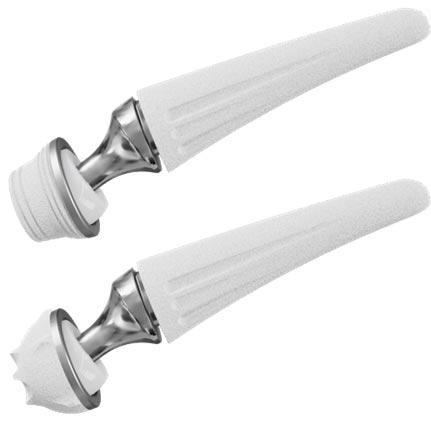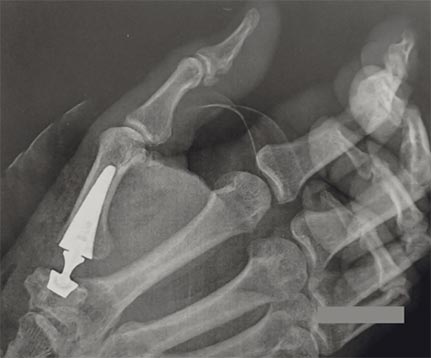Base of thumb joint replacement
I ball and socket resurfacing joint replacement made of stainless steel and hard plastic.


Why is a base of thumb joint replacement performed?
The primary reason to undergo a base of thumb joint replacement is to resolve pain at the base of the thumb that becomes worse with movement or activity (e.g., turning a key, opening a door or jar lid, lifting a cup, peeling vegetables, combing hair, etc.). If left untreated, the pain may be felt even during inactivity or rest and result in deformity at the base of the thumb.
Other indications for a base of thumb joint replacement can be:
- Tenderness, swelling, and stiffness at the base of the thumb.
- A thumb that appears crooked with limited range of motion.
- Difficulty in gripping or grasping objects or in pinching.
- Feeling of a ‘crunchy’ sound at the thumb base with certain movements.
What are the Benefits of the Procedure?
A base of thumb joint replacement improves how your thumb functions. Added benefits of the procedure include:
- Quicker recovery and better function than a Trapeziectomy which is the traditional operation.
- Less or no pain.
- Better grip or grasp and pinch strength.
- Increased mobility and flexibility of the thumb.
How is the Procedure Performed?
During the procedure, the surgeon is likely to:
- Numb your arm using a regional or general anaesthesia.
- Make an incision in the back of the hand at the base of your thumb.
- Excised a thin portion of bone on each side of the joint.
- Prepare the bone by sizing the implants to your individual anatomy and implant the implants.
- Close the joint lining and then your skin with absorbable sutures.
- Apply a dressing and bandage (no plaster cast) to the operated spot to protect your thumb.
What are the Risks Associated with a base of thumb joint replacement?
Potential risks or complications associated with a base of thumb joint replacement are:
- Continued pain, swelling, stiffness or weakness in the hand.
- Nerve damage and numbness along the side of your thumb.
- Unsightly scarring with tenderness or bleeding or infection.
What Precautions should be Taken as You Recover from a base of thumb joint replacement?
Two weeks after the surgery, your bandage will be removed and you will be given a removable splint which can be worn as much or as little as you wish as a painkiller if required.
If worn, this splint should be removed regularly while performing the exercises recommended by the surgeon. Exercises should be performed slowly to make sure they do not cause too much discomfort.
As you recover, you are expected to:
- Keep the dressing clean and dry for 2 weeks from the surgery.
- Keep your hand elevated for at least 48 hours after the surgery.
- Avoid dangling your hands by your side when you walk.
- Rest your hand on a pillow or cushion instead of your lap when you sit.
- Report any signs of wound infection, such as redness or pus to your surgeon.
- Recovery to full function may take 2-3 months, but you will have good use of the hand after 2 weeks.